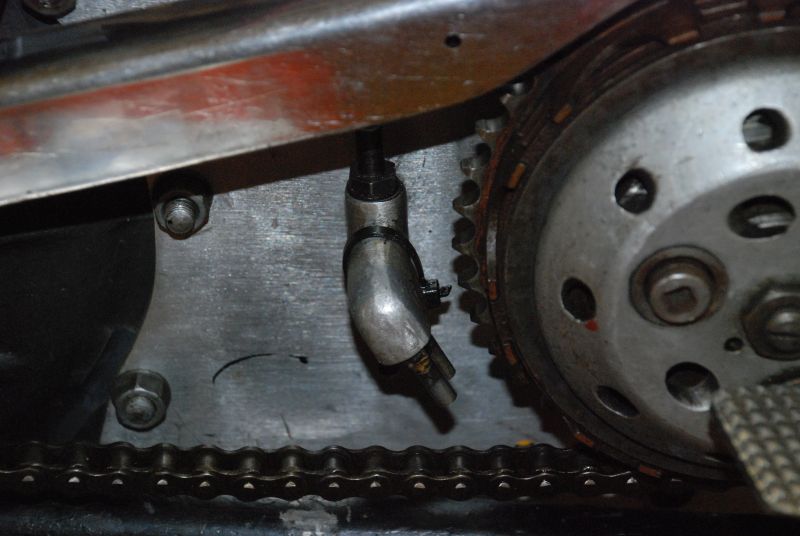Theres a Domiracer for sale on the classicdriver.com website, with 24 excellent close-up photos.
The description says
“Period "Domiracer" circa 1963. Believed to be an "ex-works" engine. Schafflietner 6-speed gearbox. Previously owned by John Holder and purchased in 1985.Raced in the 1990s by its current owner and paraded more recently. Goodwood eligible. Interesting history file containing correspondence regarding the bike's authenticity and a letter from John Hudson (ex-Norton race team) stating that the engine is a consecutive number from the works units”
But what caught my eye was the opening comment that its an “Oil in frame model in running order”: it clearly shows a normal central ally oil tank feeding the bottom end, and no sign of another oil filler cap near the petrol tank or frame, so I’m assuming its just error and ignorance. Engine does seem to have the oil-fed camshaft though….
But it got me wondering- surely the featherbed is the frame least suited to act as an oil tank??!!
Cylinder head
- Log in to post comments
Thanks for that explanation…
Thanks for that explanation Mikael. Yes the primary chain oiler is clearly visible, I think I have something similar in a box somewhere in the garage, bought at autojumble a long time ago. I just assumed it fed off a simple reservoir somewhere, so what are the connections and arrangement with the oil in the frame? Just curious!
- Log in to post comments
You fill oil oil through a…
You fill oil oil through a small internal thread stud on the left top frame tube, quite close to the steering head. Then you have the tap clearly visible in your picture #1. The rubber or plastic tube down to the twin nozzle piece that feeds the oil to both sides of the chain rollers. There is Amal main jets in it, which can be changed for more or less flow.

- Log in to post comments
Domiracer Camshaft Direct Oil Feed
Hi Mikael
Direct oil feed to the end of the camshaft must prove provenance.
Any chance you could write an article on the Domiracer(s) for the NOC magazine, Roadholder, please?
Information on these rare bikes is sketchy in the usual Norton books.
Apparently Doug Hele and his team tried many configurations but articles usually end by saying that when the race shop was shut down and Paul Dunstall got a lot of components, no tech info or drawings were there so development stagnated.
Any help appreciated.
Tim S
- Log in to post comments
Interesting the engine…
Interesting the engine number is from 1963 but stamped in unusual location, yet the head is earlier. I wonder why the earlier head was chosen and then made more like the later? Also...what is the little mark above the number? Looks a bit like a later variation of the mysterious pawnbrokers' balls signs on many but not all prewar Inters.
The direction of the lock wire on the exhaust rose can be changed...
- Log in to post comments
Serious Mods
This engine has a standard late 1950s T2225 head onto which appears to have been welded the top fins, front and rear ports from a 650 22707 casting. This would need a great deal of serious welding to achieve a good result and possibly it is more likely that somebody had access to the casting moulds in order to create their own special.
As the T2225 head had smaller inlet valves and I guess these were enlarged during the build.
The engine number appears to be 101431 which puts it in the middle of a February 1962 batch of Nortons. I am wondering if this was one of a batch of 50 short stroke Norton 500cc engines built for Gus Kuhn in the 1960s. These had 68mm bores, 650 pistons and specially made (68mm short stroke) crankshafts..
Adding a bit more to this interesting motor.
The bike was built at Bracebridge as a special order Model 88 to Daytona Spec. In which case it should have been sporting a proper 22707 SS cylinder head with twin horizontal carb mountings. tuned head, possible lightened rockers and crankshaft, racing Magneto and other 'go-faster' additions.
When completed it was shipped out to Berliner in the States.
The head it is wearing is around 5 years older.
- Log in to post comments




Looks like a heavily reworked cylinder head. Pre '59 with wide bore exhaust ports but modified to steep downdraught inlets?
A lot of work has gone into the bike. Not oil in frame though.